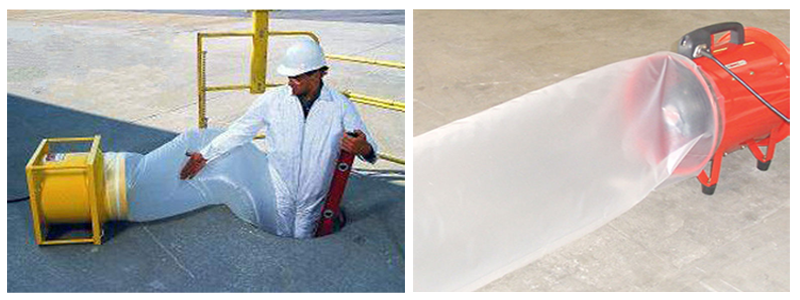The PE plastic film air duct is seamless, and formed with double layer ivory translucentPE fabric. It is used to supply fresh air to the cabin during ship maintenance.
| Advantage: | Disadvantage: |
|
1. Low cost. 2. Easy cutting. 3. Convenient storage, rool back after using. |
1. Ventilating only under positive pressure condition. It can't be used in negative pressure. 2. Not fire retardant, it will be burned through easily. 3. Can't supply air for the turning corner. |
PE film ducts, or Polyethylene Film Ducts, are versatile flexible ducts used in various industrial and construction applications. However, like any other product, they come with their set of advantages and disadvantages. In this section, the author would illustrate the strengths and weaknesses of PE film ducts to help you make informed decisions when considering their use.
Given the various application condtions, DFV specially design to this excellent PE film duct. Here are the main advantages of DFV's PE film duct.
Cost-Effective: One of the primary advantages of PE Film Ducts is their affordability. They are a cost-effective solution for temporary ventilation needs in construction sites or industrial settings. This cost-effectiveness allows businesses to save money while maintaining efficient airflow.
Ease of Cutting: PE film ducts are designed for user convenience. They can be easily cut to the required length without specialized tools, making them adaptable to various project requirements. This feature ensures that you can customize your ducts for specific applications, saving both time and resources.
Convenient Storage: PE film ducts are highly flexible and can be rolled back after use. This compact storage capability minimizes the space needed to store them when they are not in use. Such convenience is especially valuable in situations where space is limited or when you need to transport them between job sites.
However, this PE film ducts also have some drawbacks.
●Limited Ventilation in Negative Pressure Conditions: PE Film Ducts are effective for ventilating spaces under positive pressure conditions, such as inflating them with air to direct airflow. However, they are not suitable for negative pressure conditions, where the ducts would need to withstand inward airflow. This limitation restricts their use in specific environments where negative pressure is required, such as containment for hazardous materials.
●Lack of Fire Retardancy: Another disadvantage of flexible air ducts is their vulnerability to fire. These ducts are not fire-retardant, which means they can catch fire and burn easily when exposed to open flames or high temperatures. In situations where fire safety is a concern, alternative ducting materials with fire-resistant properties may be more appropriate.
●Limited Capability for Turning Corners: PE film ducts are typically straight and not designed for sharp bends or corners. When a ventilation system requires airflow to navigate tight turns or corners, PE Film Ducts may prove less practical. In such cases, more flexible or specialized ducting solutions may be necessary to ensure efficient airflow distribution.
When it comes to ship maintenance, ensuring a continuous and clean supply of fresh air to the cabin is of paramount importance. That's where our PE plastic film air duct steps in, setting the gold standard for durability, performance, and reliability in the marine industry.
